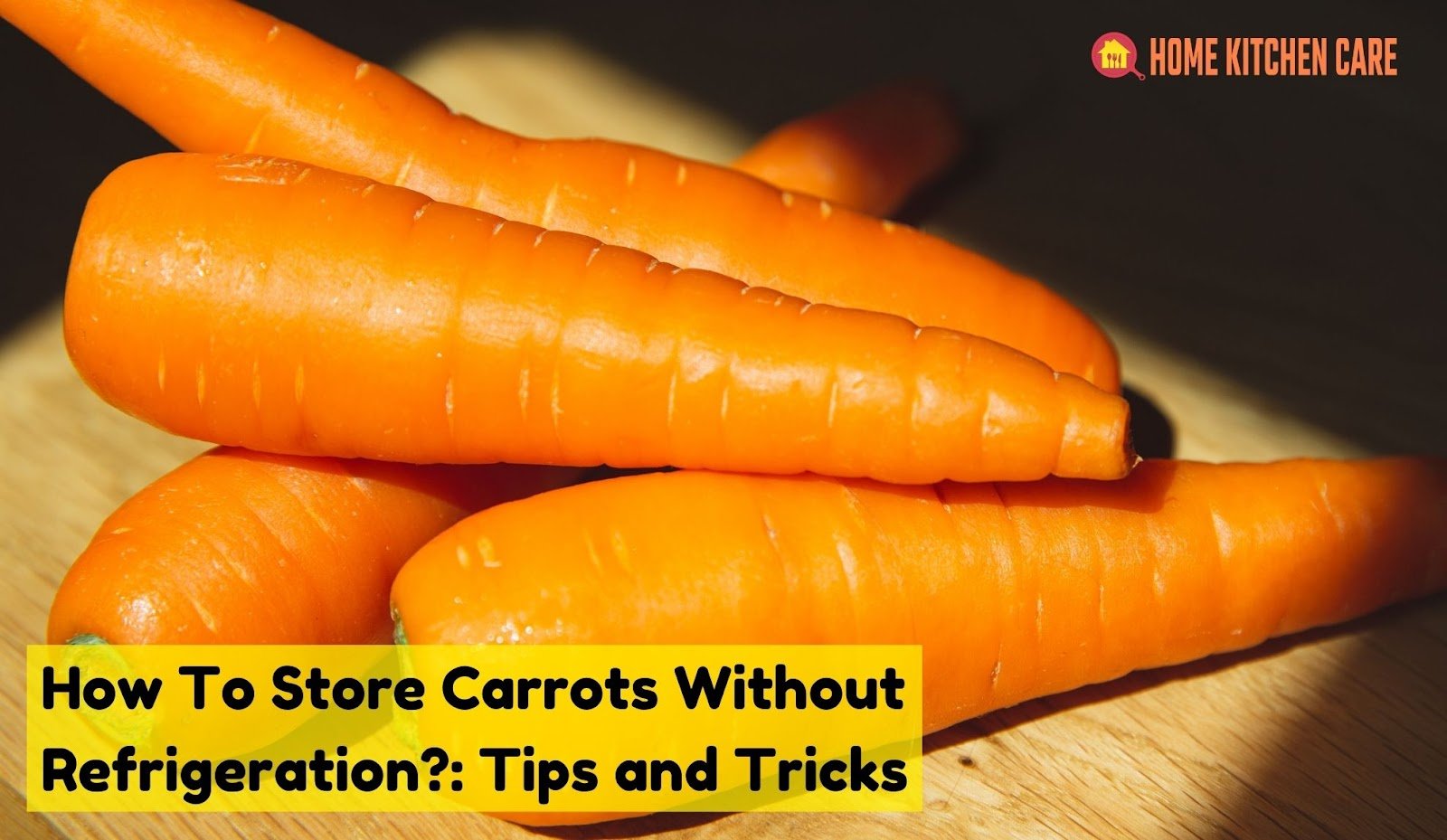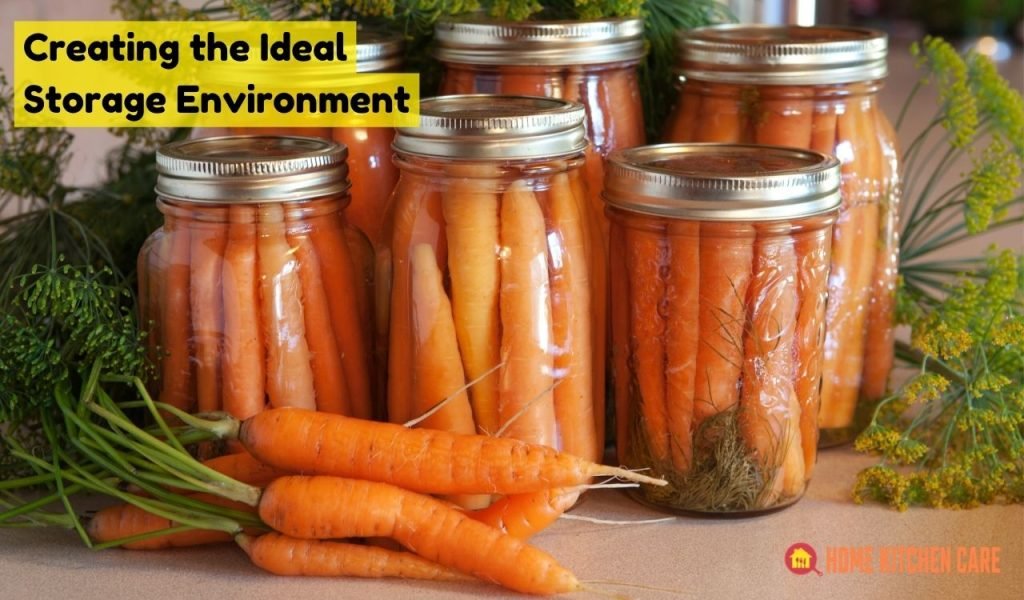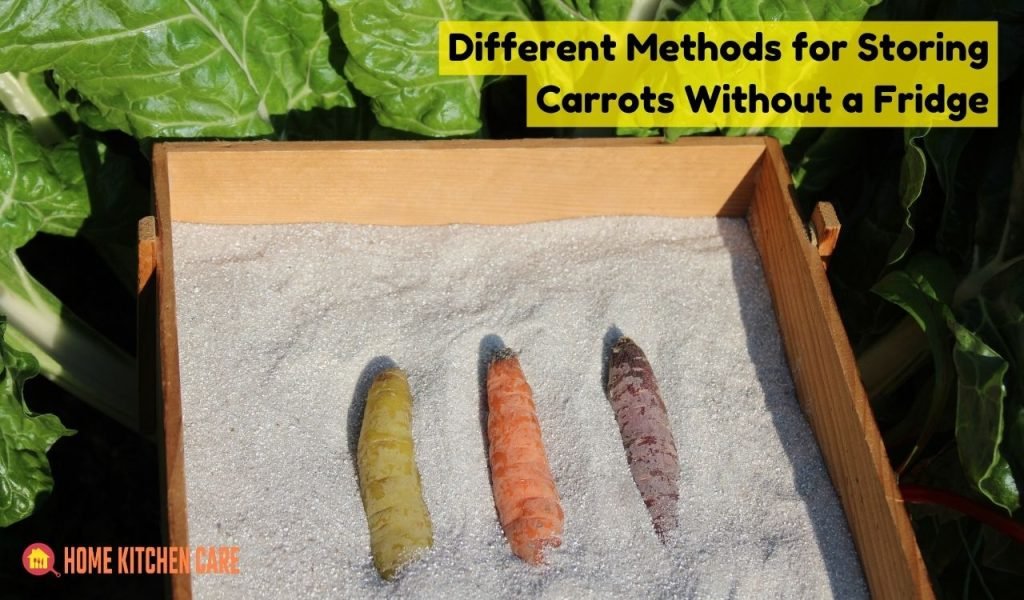Physical Address
304 North Cardinal St.
Dorchester Center, MA 02124
Physical Address
304 North Cardinal St.
Dorchester Center, MA 02124

How to store carrots without refrigeration? You might be surprised at how easy it is to keep this versatile vegetable fresh without the need for a fridge. Whether you’ve harvested a bountiful crop from your garden or want to stock up on carrots without overloading your refrigerator, we’ve got you covered.
In this quick guide, we’ll unveil some ingenious, non-refrigerated methods that’ll keep your carrots crisp and flavorful. Say goodbye to concerns about limited fridge space or power outages – it’s time to unlock the secrets of carrot storage that go beyond the icebox. Let’s dive into these simple yet effective techniques.
Key Summary: How To Store Carrots Without Refrigeration?
Store carrots without refrigeration: Utilize root cellars or straw storage for ideal cool, dark, and humid conditions. Regularly inspect for freshness and remove any spoiled carrots to maintain overall quality. These methods ensure your carrots stay crisp and flavorful for an extended period.
Selecting the right carrots is the initial step towards successful non-refrigerated storage. Making the right choices at this stage can significantly impact the longevity and quality of your stored carrots. Here’s how to choose the best carrots for non-refrigerated storage in under 400 words.
When choosing carrots for non-refrigerated storage, prioritize freshness:
Inspect your chosen carrots for any visible signs of damage:
Before storage, resist the temptation to peel your carrots:
By prioritizing freshness, avoiding damaged carrots, and keeping them unpeeled, you can ensure that you’re starting with the best possible carrots for successful non-refrigerated storage. These simple yet essential steps will help you enjoy crisp and flavorful carrots for an extended period.

When it comes to storing carrots without refrigeration effectively, creating the ideal storage environment is crucial. Carrots, like many vegetables, have specific requirements to maintain their freshness and crispness over time. Here’s how to ensure the perfect storage conditions:
The first step is to find the right temperature and location for your carrot storage. Aim for a cool, dark spot with a temperature range between 32°F (0°C) and 40°F (4.4°C). This range helps slow down the natural aging process of carrots.
Proper ventilation is essential to prevent moisture buildup and maintain a suitable environment for carrot storage. Good airflow helps reduce the risk of rot and mold. In a root cellar, ensure that there is adequate ventilation to control humidity levels. For other storage areas, you can use crates or bins with gaps to promote airflow.
Carrots should be stored separately from fruits that produce ethylene gas, such as apples and bananas. Ethylene gas can accelerate ripening and spoilage of carrots. Keep them in separate containers or areas to maintain freshness.
By creating the ideal storage environment with the right temperature, good ventilation, and separation from ethylene producers, you can maximize the shelf life of your carrots without refrigeration. These measures will help you enjoy crisp and flavorful carrots for an extended period.

Carrots are a versatile and nutritious vegetable, but keeping them fresh without refrigeration can be a challenge. Fortunately, there are several effective methods for storing carrots without a fridge. Whether you have a root cellar, basement, or simply a cool, dark corner, these techniques will help you extend the shelf life of your carrots.
Method: Root cellars are ideal for long-term carrot storage. They offer a cool, dark, and naturally humid environment.
Root cellars provide the ideal conditions for carrot storage, with a cool, dark, and naturally humid environment that helps maintain freshness over an extended period.
Method: Sand bed storage is a classic technique that maintains carrot freshness.
The sand helps maintain moisture levels and prevents carrots from drying out while keeping them separate to prevent spoilage
Method: This method uses straw as an insulating and moisture-absorbing material.
The straw provides insulation and absorbs excess moisture, helping to keep the carrots fresh for an extended period.
Method: If you lack indoor storage options, a shaded outdoor area can work.
Shaded outdoor storage can be effective, especially during cooler seasons when outdoor temperatures mimic the conditions of a root cellar.
Method: Ventilated plastic storage bins or baskets are convenient for indoor storage.
Ventilated bins maintain proper airflow, reducing the risk of moisture buildup and rot.
Method: Similar to sand bed storage, but in a barrel.
Barrels provide an alternative to wooden boxes for sand-based storage, and their tight seals can help maintain humidity levels.
Method: An outdoor trench can provide excellent cool storage.
Trench storage takes advantage of the naturally cool outdoor environment to keep carrots fresh.
Method: Create a DIY root cellar in your basement or a cool, dark corner.
A homemade root cellar can be a cost-effective way to mimic the conditions of a traditional root cellar and preserve carrots effectively.
Method: Clamping involves creating a mound of carrots covered with straw and earth.
Clamping is a traditional method that provides an insulation layer to maintain carrot freshness
Method: Preserve carrots through canning or pickling processes.
Canned or pickled carrots can be stored in a cool, dark pantry or cellar, allowing you to enjoy them year-round.
Method: Dehydrate carrots for long-term storage.
Dehydrated carrots are versatile and can be rehydrated for various culinary uses.
Method: For short-term storage, freezing is an option.
While not a long-term solution, freezing can extend the shelf life of carrots for several months.
Method: Similar to sand bed storage but in a box.
This method combines the benefits of sand storage with the convenience of wooden containers.
Each of these methods offers unique advantages depending on your available space, climate, and desired storage duration. Whether you have access to a root cellar or need to make do with outdoor options, these techniques will help you keep your carrots fresh and delicious without the need for a fridge.

Storing carrots without refrigeration can be a successful endeavor with the right techniques and a little diligence. To ensure your non-refrigerated carrots stay fresh, it’s essential to implement proper monitoring and maintenance practices. Regularly checking on your stored carrots and making necessary adjustments will help you enjoy their freshness for an extended period. In this guide, we’ll explore the key steps for effectively monitoring and maintaining your non-refrigerated carrot storage.
Regular inspections are essential to catch any signs of spoilage or issues early, preventing the spread of problems to other carrots.
Carrots require specific environmental conditions to stay fresh. Monitoring and adjusting these conditions as needed are crucial.
Rotating stored carrots helps ensure even exposure to optimal storage conditions and prevents carrots from sticking together.
Separating carrots from ethylene-producing fruits prevents premature ripening and spoilage.
Maintaining proper humidity levels is crucial to prevent carrots from drying out or becoming overly moist.
Keeping records of your inspections and maintenance activities can help you identify patterns and make informed adjustments.
The external environment can impact the conditions inside your storage area. Being adaptable is key to maintaining freshness.
Continuously educate yourself about carrot storage best practices and troubleshoot any issues you encounter.
By following these monitoring and maintenance steps, you can significantly increase the shelf life of your non-refrigerated carrots. Keeping a close eye on your stored carrots, adjusting environmental conditions as needed, and addressing any issues promptly will help you enjoy fresh and delicious carrots throughout the year.
Remember that practice makes perfect, and with time, you’ll become an expert at preserving the quality of your carrots without the need for a fridge.
Storing carrots without refrigeration is not only possible but also a rewarding skill to master. By choosing the right storage method, maintaining optimal conditions, and regularly monitoring your carrots, you can enjoy their freshness for an extended period.
Whether you have access to a root cellar or rely on DIY techniques, your efforts will be rewarded with delicious, homegrown carrots year-round. Experiment with these methods, adapt to your environment, and savor the natural goodness of your carrots without the need for a fridge.
Carrots can last for several weeks to a few months without refrigeration, depending on storage conditions. Properly stored in a cool, dark place with good airflow, they can maintain freshness for an extended period.
The best way to store raw carrots without refrigeration is in a root cellar, sand bed, or straw storage. These methods maintain a cool, dark, and humid environment that preserves the freshness of the carrots.
Yes, you can store carrots outside the fridge. Various non-refrigerated methods, such as root cellars, sand beds, and straw storage, are effective in keeping carrots fresh for an extended period.
For short-term storage overnight, you can simply keep carrots in a cool, dark place like a pantry or cupboard. If needed, airtight containers or plastic bags can help prevent moisture loss.
To store carrots without refrigeration for winter, consider using a root cellar or an insulated outdoor storage area. These options provide the consistent cool and dark conditions necessary to keep carrots fresh during the colder months.
To keep carrots fresh for an extended period, choose the right storage method, maintain proper environmental conditions (temperature and humidity), and regularly inspect and remove any spoiled carrots to prevent issues from spreading. Properly stored, carrots can stay fresh for months.